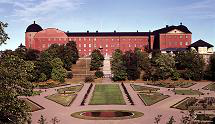Speaker
Dr
Chloé Malbrunot
(SMI (Austrian Academy of Science))
Description
The ASACUSA CUSP collaboration at the Antiproton Decelerator of CERN is planning to measure the ground-state hyperfine splitting of antihydrogen using an atomic spectroscopy beamline. Antihydrogen is the simplest atom consisting entirely of antimatter. Since its matter counterpart is one of the most precisely measured atoms in physics, a comparison of antihydrogen and hydrogen could provide one of the most sensitive tests of CPT symmetry.
The setup consists of a source of partially polarized antihydrogen atoms [1,2] emitted toward a radiofrequency spin-flip cavity with its resonance frequency tuned to the hyperfine transition. A superconducting sextupole magnet serves as spin analyser before the detection of the atoms in an antihydrogen detector [3].
Monte Carlo simulations show that the antihydrogen ground-state hyperfine splitting can be determined in such a beam setup at a relative precision of 0.1ppm which would already provide one of the best test of CPT.
My talk will present the latest developments on the spectroscopy apparatus downstream of the antihydrogen polarizing source, the coming years program to achieve the above mentioned precision as well as a short overview of the atomic hydrogen beamline developed to test the performance of the spectroscopy apparatus during the CERN accelerator shutdown LS1.
[1] Y. Enomoto et al., Phys. Rev. Lett. 105, 243401 (2010).
[2] N. Kuroda et al., Hyperfine Interact 209:3541 (2012).
[3] E. Widmann et al., Hyperfine Interactions doi:10.1007/s10751-013-0809-6 (2012).
Co-authors:
C .Sauerzopf(1), P. Caradonna(1), M. Diermaier(1), N. Dilaver(1), S. Federmann(1,2), B. Kolbinger(1), M. Leali(3), V. Mascagna(3), O. Massiczek(1), K. Michishio(4), T. Mizutani(5), A. Mohri(6), D. Murtagh(6), H. Nagahama(5), Y. Nagashima(4), Y. Nagata(6), M. Ohtsuka(5), B. Radics(6), S. Sakurai(7), K. Suzuki(1), S. Tajima(5), H.A. Torii(4), S. Van Gorp(6), L. Venturelli(3), M. Wolf(1), B. Wunschek(1), ,J. Zmeskal(1), N. Zurlo(3), E. Lodi-Rizzini(3) , H. Higaki(7), Y. Kanai(6), N. Kuroda(5), Y. Matsuda(5), S. Ulmer(6), E. Widmann(1), Y. Yamazaki(6)
(1) Stefan-Meyer-Institut fur subatomare Physik, der Osterreichischen Akademie der Wissenschaften, Boltzmanngasse 3, A-1090, Austria
(2) CERN, 1211 Geneva, Switzerland
(3) Dipartimento di Chimica e Fisica per lIngegneria e per i Materiali ,Universit di Brescia & Istituto Nazionale di Fisica Nucleare, Gruppo Collegato di Brescia, 25133 Brescia, Italy
(4) Department of Physics,Tokyo University of Science, Kagurazaka, Shinjuku,Tokyo162-8601, Japan
(5) Graduate School of Arts and Sciences, University of Tokyo, Komaba, Meguro, Tokyo 153-8902, Japan
(6) RIKEN Advanced Science Institute, 2-1Hirosawa, Wako,Saitama 351-0198, Japan
(7) Graduate School of Advanced Sciences of Matter, Hiroshima University, Kagamiyama, Higashi-Hiroshima, Hiroshima 739-8530, Japan
Primary author
Dr
Chloé Malbrunot
(SMI (Austrian Academy of Science))

